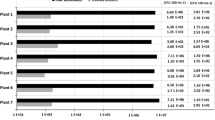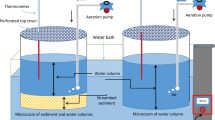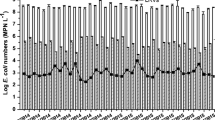Abstract
In order to assess and accurately predict the self-purification capabilities of rivers with respect to enteric pollution, a thorough understanding of mechanisms such as dispersion, particle association, and inactivation in the water column is crucial. In this study, we firstly performed particle size distribution analyses of wastewater and investigated the Escherichia coli and enterococci loadings of each size fraction. It was seen that 91 % of E. coli and 83 % of enterococci were associated with particle sizes less than or equal to 12 μm. Particles larger than 63 μm contributed less than 1 % to overall E. coli and enterococci loadings. Based on these results, batch experiments were performed to investigate the effect of particle size and total suspended solids (TSS) concentration on UV inactivation of the two fecal indicator bacteria (FIB). A direct relationship between the particle size to which FIB were associated and their UV inactivation rate was noted. E. coli and enterococci associated with particles smaller than or equal to 12 μm were inactivated on average 2 × and 1.7 × faster than those associated with the larger particle fraction of 12 to 63 μm. It was additionally seen that as the TSS concentrations increased, the UV inactivation rates decreased. A tailing effect of UV inactivation was however noted at TSS concentrations above approximately 100 mg L−1.



Similar content being viewed by others
References
Ahn, J.H. (2012). Size distribution and settling velocities of suspended particles in a tidal embayment. Water Research, 46(10), 3219–3228.
Auer, M.T., & Niehaus, S.L. (1993). Modeling fecal coliform bacteria - I. Field and laboratory determination of loss kinetics. Water Research, 27(4), 693–701.
Burkhardt III, W., Calci, K.R., Watkins, W.D., Rippey, S.R., Chirtel, S.J. (2000). Inactivation of indicator microorganisms in estuarine waters. Water Research, 34, 2207–2214.
Characklis, G.W., Dilts, M.J., Simmons, O.D., Likirdopulos, C.A., Krometis, L.A.H., Sobsey, M.D. (2005). Microbial partitioning to settleable particles in stormwater. Water Research, 39, 1773–1782.
Chigbu, P., Gordon, S., Strange, T. (2005). Fecal coliform bacteria disappearance rates in a north-central Gulf of Mexico estuary. Estuarine, Coastal and Shelf Science, 65(1-2), 309–318.
Cole, J.J. (1982). Interactions between bacteria and algae in aquatic ecosystems. Annual Review of Ecological Systems, 13, 291–314.
Davies, C.M., & Bavor, H.J. (2000). The fate of stormwater-associated bacteria in constructed wetland and water pollution control pond. Journal of Applied Microbiology, 89, 349–360.
de Brauwere, A., de Brye, B., Servais, P., Passerat, J., Deleersnijder, E. (2011). Modelling Escherichia coli concentrations in the tidal Scheldt river and estuary. Water Research, 45(9), 2724–2738.
Droppo, I.G., Liss, S.N., Williams, D., Nelson, T., Jaskot, C., Trapp, B. (2009). Dynamic existence of waterborne pathogens within river sediment compartments. Implications for water quality regulatory affairs. Environmental Science & Technology, 43(6), 1737–1743.
Fries, J.S., Characklis, G.W., Noble, R.T. (2006). Attachment of fecal indicator bacteria to particles in the Neuse River estuary, N.C. Journal of Environmental Engineering, 132, 1338–1345.
Fries, J.S., Characklis, G.W., Noble, R.T. (2008). Sediment-water exchange of Vibrio sp. and fecal indicator bacteria: Implications for persistence and transport in the Neuse River Estuary, North Carolina, USA. Water Research, 42, 941–950.
Gao, G., Falconer, R.A., Lin, B. (2011). Numerical modelling of sediment-bacteria interaction processes in surface waters. Water Research, 45(5), 1951–1960.
Gerba, C.P., & McLeod, J.S. (1976). Effect of sediments on the survival of Escherichia coli in marine waters. Applied and Environmental Microbiology, 32, 114–120.
ISO (1998a). EN 7899-1: Detection and enumeration of intestinal enterococci – Part 1: miniaturized method (most probable number) for surface and waste water.
ISO (1998b). EN 9308-3: Detection and enumeration of Escherichia coli and coliform bacteria – Part 3: miniaturized method (most probable number) for the detection and enumeration of E. coli in surface and waste water.
Jamieson, R., Gordon, R., Joy, D., Lee, H. (2004). Assessing microbial pollution of rural surface waters: a review of current watershed scale modeling approaches. Agricultural Water Management, 70(1), 1–17.
Jamieson, R., Joy, D.M., Lee, H., Kostashuk, R., Gordon, R. (2005). Transport and deposition of sediment-associated Escherichia coli in natural streams. Water Research, 39, 2665–2675.
Jeng, H., England, A., Bradford, H. (2005). Indicator organisms associated with stormwater suspended particles and estuarine sediment. Journal of Environmental Science and Health, 40(4), 779–791.
Kollu, K., & Örmeci, B. (2012). Effect of particles and bioflocculation on ultraviolet disinfection of Escherichia coli. Water Research, 46(3), 750–760. doi:10.1016/j.watres.2011.11.046.
Krometis, L.A.H., Characklis, G.W., Simmons III, O.D., Dilts, M.J., Likirdopulos, C.A., Sobsey, M.D. (2007). Intra-storm variability in microbial partitioning and microbial loading rates. Water Research, 41, 506–516.
Madge, B.A., & Jensen, J.N. (2006). Ultraviolet disinfection of fecal coliform in municipal wastewater: Effects of particle size. Water Environment Research, 78(3), 294–304.
Örmeci, B., & Linden, K.G. (2002). Comparison of UV and chlorine inactivation of particle and non-particle associated coliform. Water Science & Technology, 2(5–6), 403–410.
Pommepuy, M., Guillaud, J.F., Dupray, E., Derrien, A., Le Guyader, F., Cormier, M. (1992). Enteric bacteria survival factors. Water Science & Technology, 25(12), 93–102.
Qualls, R.G., Flynn, M.P., Johnson, J.D. (1983). The role of suspended particles in ultraviolet disinfection. Water Pollution Control Federation, 55(10), 1280–1285.
Qualls, R.G., Ossoff, S.F., Chang, J.C.H., Dorfman, M.H., Dumais, C.M., Lobe, D.C., Johnson, J.D. (1985). Factors controlling sensitivity in ultraviolet disinfection of secondary effluents. Water Pollution Control Federation, 57(10), 1006–1011.
Rehmann, C.R., & Soupir, M.L. (2009). Importance of interactions between the water column and the sediment for microbial concentrations in streams. Water Research, 43, 4579–4589.
Schillinger, J.E., & Gannon, J.J. (1985). Bacterial particles adsorption in urban suspended stormwater. Water Pollution Control Federation, 57(5), 384–389.
Schultz-Fademrecht, C., Wichern, M., Horn, H. (2008). The impact of sunlight on inactivation of indicator microorganisms both in river water and benthic biofilms. Water Research, 42, 4771–4779.
Servais, P., Garcia-Armisen, T., George, I., Billen, G. (2007). Fecal bacteria in the rivers of the Seine drainage network (France): Sources, fate and modelling. Science of the Total Environment, 375, 152–167.
Sinton, L., Hall, C., Braithwaite, R. (2007). Sunlight inactivation of Campylobacter jejuni and Salmonella enterica, compared with Escherichia coli, in seawater and river water. Journal of Water and Health, 5, 357–365.
Sinton, L.W., Finlay, R.K., Lynch, P.A. (1999). Sunlight inactivation of fecal bacteriophages and bacteria in sewage-polluted seawater. Applied and Environmental Microbiology, 65(8), 3605–3613.
Tiehm, A., Nickel, K., Zellhorn, M., Neis, U. (2001). Ultrasonic waste activated sludge disintegration for improving anaerobic stabilization. Water Research, 35(8), 2003–2009.
Vaze, J., & Chiew, F.H.S. (2004). Nutrient loads associated with different sediment sizes in urban stormwater and surface pollutants. Journal of Environmental Engineering, 130(April), 391–396.
Whitby, G.E., & Palmateer, G. (1993). The effect of UV transmission, suspended solids and photoreactivation on microorganisms in wastewater treated with UV light. Water Science & Technology, 27(3-4), 379–386.
Acknowledgments
This research was supported by the German Research Foundation (DFG HO 599 1910/9-1 and RU 1546/2-1) and the Oswald-Schulze Foundation (OSS 1596/11). We would like to thank Hubert Moosrainer and Ursula Wallentits of the Chair of Urban Water Systems Engineering for their technical assistance as well as Dr. Steffen Krause of the Bundeswehr University Munich for allowing us to perform particle size distribution measurements with their instrument.
Author information
Authors and Affiliations
Corresponding author
Rights and permissions
About this article
Cite this article
Walters, E., Graml, M., Behle, C. et al. Influence of Particle Association and Suspended Solids on UV Inactivation of Fecal Indicator Bacteria in an Urban River. Water Air Soil Pollut 225, 1822 (2014). https://doi.org/10.1007/s11270-013-1822-8
Received:
Accepted:
Published:
DOI: https://doi.org/10.1007/s11270-013-1822-8




